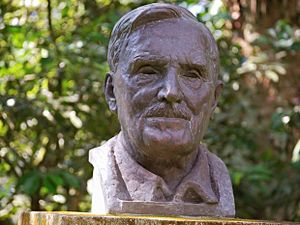Henri François Pittier facts for kids
Quick facts for kids
Henri François Pittier de Fabrega
|
|
|---|---|
 |
|
| Born | August 13, 1857 Bex, Switzerland
|
| Died | January 27, 1950 (aged 92) Caracas, Venezuela
|
| Nationality | Swiss |
| Alma mater | University of Jena |
| Scientific career | |
| Fields | Geography |
Henri François Pittier de Fabrega (born August 13, 1857, in Bex, Switzerland – died January 27, 1950, in Caracas, Venezuela) was a Swiss geographer and botanist. He is famous for starting the national park system in Venezuela.
A Life of Discovery
Henri Pittier studied engineering at the University of Jena in Germany. In 1887, he moved to Costa Rica. There, he started the Physical Geographic Institute and a special collection of dried plants called an herbarium.
He collected many different types of fungi and spiders in Costa Rica. Other scientists, like Marietta Hanson Rousseau and Elisa Caroline Bommer, later studied and wrote about his findings.
Work in Venezuela
In 1917, Pittier arrived in Venezuela. He spent many years studying the plants and animals there. He identified and classified over 30,000 different plants!
Thanks to his efforts, Henri Pittier National Park became Venezuela's very first national park. This park was created to protect the amazing nature he loved so much.
Honoring His Legacy
Henri Pittier's work was so important that several plants and even an animal are named after him. For example, the plant genera Pittiera and Pittierella were named in his honor. Also, a type of rat, Pittier's crab-eating rat, carries his name. More than 500 different species are named after him!
The Venezuelan government even gives out an award called the Henri Pittier Order of Merit to Conservation. This award honors people who do great work in protecting nature.
His Writings
Henri Pittier wrote more than 300 papers and books. These writings covered many topics, including plants (botany), geography, forests (forestry), and even how people live (anthropology and ethnography). He also wrote about languages (linguistics), rocks (geology), and weather (climatology).
Some of his important works include:
- Primitiae florae costaricensis, 1891 (with Théophile Alexis Durand).
- Manual de agricultura tropical, 1901 (with Henry Alfred Alford Nicholls).
- Manual de las plantas usuales de Venezuela, 1926.
- Genera Plantarum Venezuelensium, 1939.
See also
 In Spanish: Henri Pittier para niños
In Spanish: Henri Pittier para niños
- Henri Pittier - Wikipedia, in Spanish

